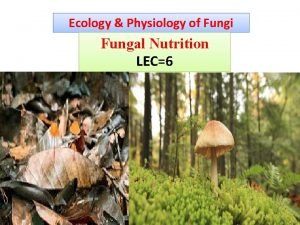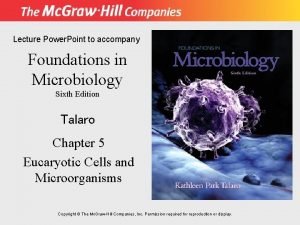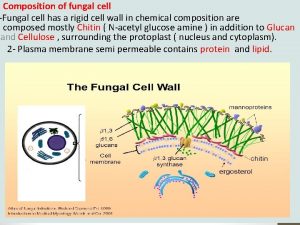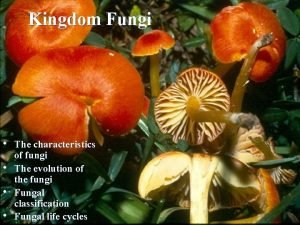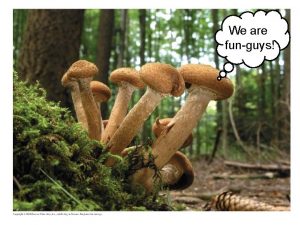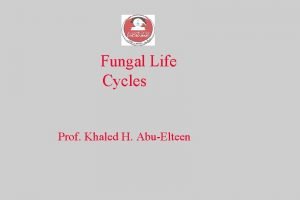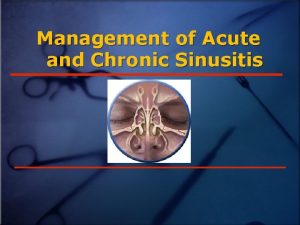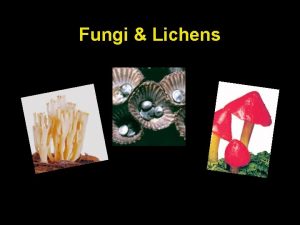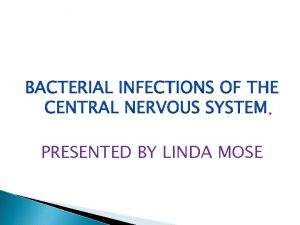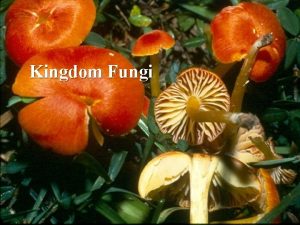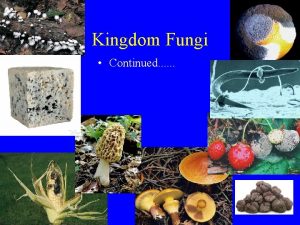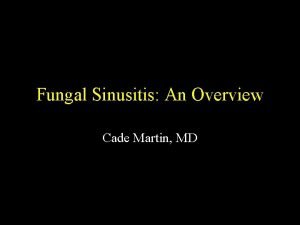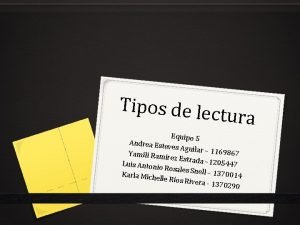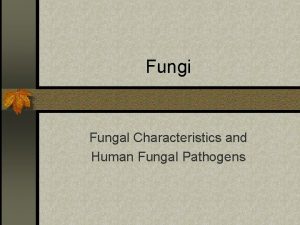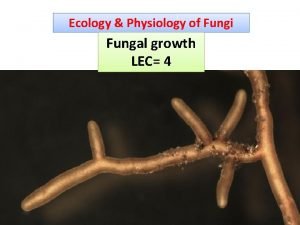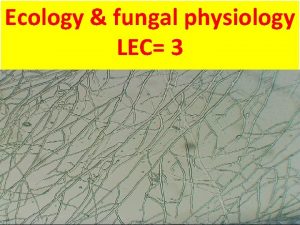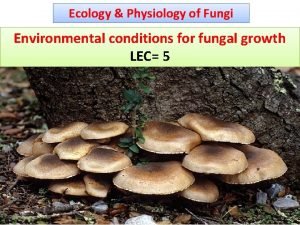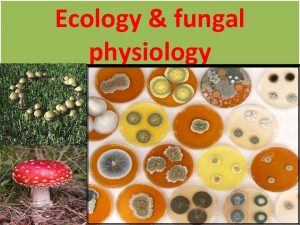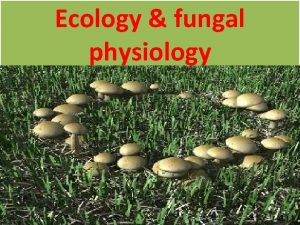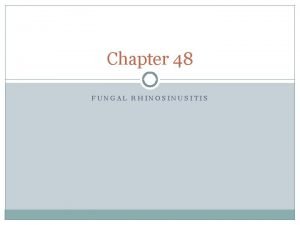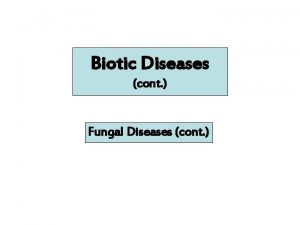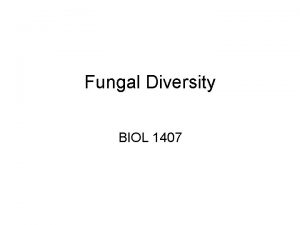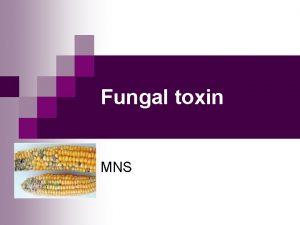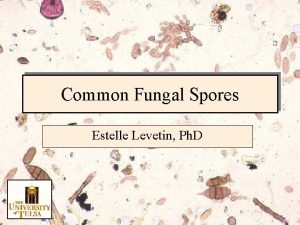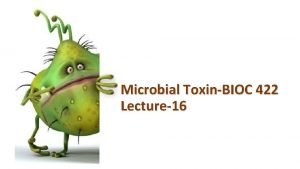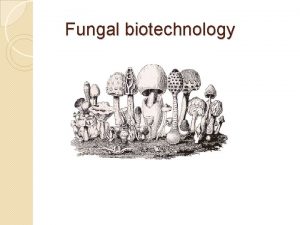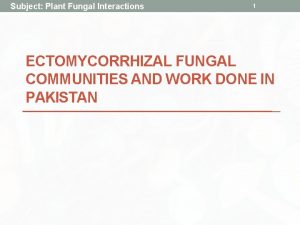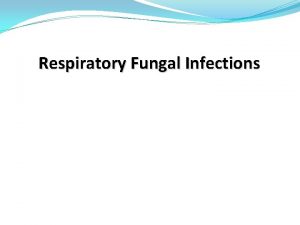Ecology fungal physiology LEC 7 Mechanism of Nutrition























- Slides: 23

Ecology & fungal physiology LEC= 7 Mechanism of Nutrition

Mechanism of Nutrition The whole mycelium may have the power to absorb these nutrients or this task may be assigned to special portions of the mycelium. In saprophytic fungi the hyphae (Mucor mucedo) or rhizodial hyphae (Rhizopus stolonifer) come in intimate contact with nutrients in the substratum (A) and absorb soluble smaller molecules such sugars and amino acids. Insoluble complex substances such as proteins, lipids and Poly are first broken into soluble monomeres (digested) by secreting extra-cellular enzymes and then absorbed. The fungal hyphae secrete enzymes which convert insoluble complex food materials in the substratum to soluble ones. The latter are then absorbed by direct diffusion either through the hyphal walls of the hyphae that penetrate the substratum or by the rhizoidal hyphae. The mycelium of the parasites is rarely ectophytic but frequently it grows inside the host. The hyphae either ramify in the intercellular space between the host cells (D) or penetrate into the host cells (G). The former are called intercellular hyphae and the latter intracellular hyphae. The intercellular hyphae obtain nutrition through the cell walls or membranes of the host cells. This they do by secreting an enzyme upon the plasma membrane of the host cell. It makes the membrane more permeable to the contained solutes. The latter diffuse out and are absorbed by the hyphal walls. The hyphal walls of the intracellular hyphae come in direct contact with the host protoplasm (G) and obtain food by direct diffusion.

The intercellular hyphae of some highly specialised (obligate) plant parasites give out slender lateral outgrowths. The hyphal outgrowth punctures the host cell wall making a minute pore through which it enters the host cell. Within the host cell, it enlarges to form a globose (D), lobed (B), or branched (F) absorptive organ.

This type of feeding organ of the parasitic fungi is called a haustorium. It is markedly specialised in structure to absorb nutrition from the host tissues. The haustonum is intracellular and thus robs the host of its food without killing it. Haustoria are characteristic of obligate parasites. They vary in shape and size in different fungi. In Albugo the haustorium is a button-like (D) or spherical structure. Peronospora parasitica has sac-like haustoria (E) in the leaf cells of Capsella. Peronospora calotheca produces branched filamentous haustorium in the stem cells of Galium (F). Erysiphe graminis forms an elongated branched haustorium inside the host cell (B).

Each haustorium (Fig. 1. 16) usually consists of two parts, a constricted region which is in the form of a narrow penetration tube and the expanded or branched region on the host cell. The penetration tube is usually clasped by a ‘collar’ of host wall material. The enlarged or expanded region of the haustorium causes Invagination of the cytoplasmic membrane of the host cell. The latter remains closely appressed to the wall of the haustorium. There is a zone of apposition enclosing the haustorium between the fungal wall and the unbroken cytoplasmic membrane of the host. Its origin is in dispute. The secretion from the haustorium upon the plasma membrane of the host makes it permeable to solutes contained in the sap cavity. They diffuse out and are then absorbed by the haustorium parastic fungi do not produce haustoria in artificial cultures. The haustona are also not produced by fungi which live as parasites on animals.

The fungi, as mentioned above, are unable to synthesize sugars from carbon dioxide and water. They, however, can synthesize from soluble sugars the more complex carbohydrates which I the chief components of their cell walls. They are also able to synthesize proteins and eventually protoplasm if supplied with carbohydrates and simple nitrogen compounds such as ammonium salts. Besides ammonium salts, they can absorb and utilize many complex but soluble organic nitrogenous compounds.

Nutrient exchange he bi-directional movement of nutrients, carbon (C) from plant to fungus, and soil nutrients from fungus to plant, is the essential feature of a mycorrhiza, and is believed to be the basis for the mutualistic association. Aside from monotropoid mycorrhizas, the juvenile stages of all orchids, and the whole lives of a few orchid species (which are achlorophyllous) there is always a two-way transfer of nutrients.

Fig. 2. Schematic illustration of a model for the exchange-transfer of phosphate and carbon compounds across the arbuscular mycorrhizal interface. Plasma membrane proton-pump ATPases and secondary transporters that have been experimentally localised in the membranes of the arbuscular interface are indicated by the circles, with the arrows indicating direction of transport.

Fig. 3. Nutrient exchange between fungus and host in the ectomycorrhiza depends on one partner releasing nutrient into the apoplastic interface and the uptake of that nutrient from the interfacial apoplast by the other partner. This diagram summarises current ideas about the transporters acting in ectomycorrhizal tissues that achieve this nutrient exchange. Key: fp, fungal plasma membrane, rp, root plasma membrane. The circles represent transporters, with the arrows indicating direction of transport. Blue circles represent transporters where at least one member of the transporter family has been characterized by functional complementation of a yeast.

Symbiotic relationships 1 - Decomposer 2 -Parasitic 3 - Mutualistic

This diversity of food sources corresponds to the varied roles of fungi in ecological communitities, with different species living as decomposers, parasites, or mutualists. Decomposer fungi break down and absorb nutrients from nonliving organic material, such as fallen logs, animal corpses, and the wastes of living organisms. Parasitic fungi absorb nutrients from the cells of living hosts. Some parasitic fungi are pathogenic, including many species that cause diseases in plants. Mutualistic fungi also absorb nutrients from a host organism, but they reciprocate with actions that benefit the host. For example, mutualistic fungi that live inside certain termite species use their enzymes to break down wood, as do mutualistic protists in other termite species

Many fungi obtain nutrition by living in mutually beneficial associations with other plants. The Association is not causal but permanent and is established during long process of evolution. The two best known examples of mutualisitc associations of fungi with other plants are Symbiosis and Mycorrhiza. Symbiosis: The common example of symbiosis is an association of a fungus and an alga in a lichen thallus. The two organisms in this association are so intertwined as to form a single composite thallus plant which different from either of the partners in form and habit. The duty of alga in this partnership is to synthesize food with the help of green chloroplasts and share it with its fungal partner. The fungus absorbs minerals in solution and water from the substratum and press on to the alga. The fungal hyphae which form the bulk of the lichen thallus provide shelter to the alga, in addition.

Fungi form two key mutualistic symbiotic associations 1 - Lichens 2 - Mycorrhizae

Lichens symbiotic associations between a fungus and a photosynthetic partner.



Mycorrhiza (pl. mycorrhizae; Gr. mykes = mushroom + rhiza = root) is the symbiotic association between higher plant roots and fungal mycelia. Many plants in nature have mycorrhizal associations. Mycorrhizal plants increase the surface area of the root system for better absorption of nutrients from soil especially when the soils are deficient in phosphorus. The nature of association is believed to be symbiotic (mutualism), nonpathogenic or weakly pathogenic. There are three types of mycorrhizal fungal associations with plant roots. They are ectotrophic or sheathing or ectomycorrhiza, . endotrophic or endomycorrhiza and ectendotrophicmycorrhiza. Arbuscular mycorrhizal fungi (AMF) are root symbiotic fungi improving plant stress resistance to abiotic factors such as phosphorus deficiency or deshydratation.


Benefits of Mycorrhiza

It is of three types: (i) Ectomycorrhiza, (ii) Endomycorrhiza, and (iii) Ectoendomycorrhiza. (i) Ectomycorrhiza: The fungal hyphae in this case form a complete envelope around the root tip and also penetrate and extend into the first few cortical layers to form an intercellular network of hyphae known as the Hartignet. The hyphal strands that extend into the substrate from the envelope absorb water and nutrients from the soil and pass them on to the roots of the plant through the Hartig’s net. The presence of the fungus thus increases root absorption. In return the fungus receives food and shelter. (ii) Endomycorrhiza: The fungal hyphae, in this case, penetrate root hairs, epidermis and reach the cortex where they grow intracellularly forming fungal knots in the cortical cells. A portion of the mycelium lives in the soil but it forms no dense hyphal growth (envelope on the surface of the root). (iii) Ectoendomycorrhiza: It is a combination of the two. The fungal hyphae form a sheath at the surface of the root. Within the root, they grow intercellularly and intracellulary.

2 - Mycorrhizae

Characteristic ECM symbiosis (ectomycorrhizae) AM symbiosis (endomycorrhizae) Fungal life style Facultative saprotroph Obligate biotroph Structural components Mantle, Hartig net, and ERM with or without rhizomorphs Arbuscules or intercellular hyphal coils, ERM, vesicles in some types Penetration Exclusively intercellularly Intercellularly and intracellularly Nutrient uptake ECM roots represent a significant pathway proportion of the nutrient absorbing surface and nutrient uptake predominately via the mycorrhizal pathway Contribution to Particularly important for N plant nutrition, but also significant contributions to P nutrition Theoretically plant and mycorrhizal pathway, but mycorrhizal pathway can dominate nutrient uptake in mycorrhizal roots Fungal nutrient resources Uptake predominately of inorganic nutrient resources, utilization of organic nutrient resources considered to be small Efficient uptake of inorganic and organic nutrient resources Particularly important for P nutrition; contributions to N nutrition still under debate

 Haustorium in fungi
Haustorium in fungi Unit 26 animal anatomy physiology and nutrition
Unit 26 animal anatomy physiology and nutrition Agriscience unit 26 self evaluation answers
Agriscience unit 26 self evaluation answers Fungal reproduction
Fungal reproduction Fungal cell wall
Fungal cell wall Nail diseases and disorders milady
Nail diseases and disorders milady Chytridiomycota examples
Chytridiomycota examples What condition do fungal organisms favor for growth
What condition do fungal organisms favor for growth There fungus among us
There fungus among us Xenospores
Xenospores Allergic fungal sinusitis treatment
Allergic fungal sinusitis treatment Sac fungi definition
Sac fungi definition Fungal uveitis
Fungal uveitis Menigitis csf
Menigitis csf Fungal cell characteristics
Fungal cell characteristics Basidiomycota
Basidiomycota Allergic fungal sinusitis
Allergic fungal sinusitis Lec hardver
Lec hardver Lec
Lec August lec 250
August lec 250 Lec scoreboard
Lec scoreboard Lec hardver
Lec hardver Lec
Lec Tipos de lec
Tipos de lec
